一、 实验题目:
词法分析程序
二、 实验内容:
1、主程序设计考虑:
主程序的说明部分为各种表格和变量安排空间(关键字和特殊符号表)。
id 和 ci 数组分别存放标识符和常数;还有一些为造表填表设置的变量。
主程序的工作部分建议设计成便于调试的循环结构。每个循环处理一个单词;接收键盘上送来的一个
单词;调用词法分析过程;输出每个单词的内部码。
2)词法分析过程考虑
该过程取名为 lexical,它根据输入单词的第一个有效字符(有时还需读第二个字符),判断单词类,
产生类号。对于标识符和常数,需分别与标识符表和常数表中已登记的元素相比较,如表中已有该元素,
则记录其在表中的位置,如未出现过,将标识符按顺序填入数组 id 中,将常数存入数组中 ci 中,并记
录其在表中的位置。
三、 程序源代码:
#include
#include
#include
#include
#define LEN sizeof(struct Node)
#define NULL 0
struct Node
{
char data;
struct Node *next;
};
void Output1(struct Node*);
void Scaner(); /*词法分析*/
void Scaner1();
void GetBC();
void GetChar();
void Concat();
int IsLetter(char ch);
int IsDegit(char ch);
int Reserve();
void Retract();
void Back(char *a,char *b);
struct Node *head,*p;
第 页
共 页
�
char ch; /*全局变量*/
char
*key[]={"int","char","float","void","const","if","else","do","while","scanf","printf","retu
rn","main"}; /*关键字表*/
char Token[20]; /*字符数组,存放构成单词的符号串*/
char *id[256];
int ci [256];
int i=0;
int j=0;
int opt;
void main()
{
head=(struct Node *)malloc(LEN); /*分配头节点存储空间*/
if(!head)
{
printf("error");
exit(1);
}
head->next=NULL;
head->data=' ';
p=head;
printf("如果想结束输入就在新的一行的开始输入’$’!\n 输入结束后屏幕上会输入你刚输入的代
码\n");
printf("请输入你的代码:\n");
while(1)
{
int i=0;
char temp[256];/*每行长度不超过 256 个字符*/
gets(temp); /*输入源程序,以行为单位*/
if(temp[0]=='$') break;/*当输入的第一个字符为$时表示输入源代码结束*/
p->next=(struct Node *)malloc(LEN);
if(!(head->next))
{
printf("error");
exit(1);
}
// p=head;
p=head->next;
while(temp[i]!='\0' && i<256)
{
/*将输入的代码以行为单位存入缓冲区*/
p->data=temp[i];
p->next=(struct Node *)malloc(LEN);
if(!(p->next))
第 页
共 页
�
{
printf("error");
exit(1);
}
p=p->next;
i++;
}
p->data='\n';
p->next=NULL;
/*尾结点*/
/*扫描缓冲区,输出结果*/
}
printf("你刚才输入的是代码为:\n");
Output1(head);
p=head->next;
printf("经该词法分析器程序处理后输出结果为:\n");
printf("注:第一个无素 1,2,3,4,5 分别表关键字、表标识符、表常数、表运算符、表界符\n");
printf("
// printf("有两种输出格式,可通输入 0 或 1 进行选择");
//opt=(int)getchar();
while(p->next!=NULL)
{
第二无素为该单词在各自表中的指针或内部码值\n");
Scaner();
}
system("pause");
//return 0;
}
void Output1(struct Node *head)
{
/*扫描缓冲区函数*/
if(!(head)) {printf("error");exit(1);}
p=head->next;
while(p->next!=NULL)
{
printf("%c",p->data);
p=p->next;
}
printf("\n");
}
void GetBC() /*若 ch 中是空白字符,则不停调用 getch()直到读入的不是空白字符为止*/
{
while (ch==' ')
GetChar();
}
void GetChar()
/*从缓冲区读入一字符*/
第 页
共 页
�
{
}
ch=p->data;
p=p->next;
void Concat()
{
/*将 ch 中的字符连接到 token 的后面*/
unsigned int i;
i=strlen(Token);
if(ch!=' ')
{
Token[i]=ch;
Token[i+1]='\0';
}
}
int IsLetter(char ch)
{
return isalpha((int)ch);
}
int IsDigit(char ch)
{
/*判断 ch 中的是否是数字*/
return isdigit((int)ch);
}
int Reserve() /*判断 token 中的字符串是否是关键字或是标识符*/
{
int k;
for(k=0;k<13;k++)
{
if(strcmp(key[k],Token)==0)
return (k+1);
}
return 0;
}
void Retract() /*指针回退一个字符*/
{
struct Node *Q;
Q=head->next;
while(Q->next!=p)
Q=Q->next;
p=Q;
}
void Back(char *a,char *b)
{
第 页
共 页
�
printf("(%s,%s)\n",a,b);
}
void Scaner()
{
int c;
Token[0]=NULL;
GetChar();
GetBC();
if(IsLetter(ch))
{
while(IsLetter(ch)||IsDigit(ch))
{
Concat();
GetChar();
}
Retract();
c=Reserve();
if(c!=0)
{
printf("<1,%d>\n",c);
}
else
{
printf("<2,%d>\n",i);
id[i]=Token;
i++;
}
}
else if(IsDigit(ch)){
while(IsDigit(ch))
{
Concat();
GetChar();
}
Retract();
printf("<3,%d>\n",j);
ci[j]=atoi(Token);
j++;
}
else
switch(ch)
{
case'+': GetChar();
if(ch=='+')
第 页
共 页
�
{
}
printf("<4,39>\n");
Retract();
printf("<4,15>\n");
break;
case'-': GetChar();
if(ch=='-')
case'&':GetChar();
case'|':GetChar();
{
printf("<4,40>\n");}
Retract();
printf("<4,16>\n");
break;
if(ch=='&')
{
printf("<4,27>\n");
}
printf("error\n");
Retract();
if(ch=='|')
{
printf("<4,28>\n");
}
Retract();
break;
case'*':
case'/':
case'%':
printf("<4,17>\n");
break;
printf("<4,18>\n");
break;
printf("<4,19>\n");
break;
case'<': GetChar();
if(ch=='=')
{
printf("<4,26>\n");
}
Retract();
printf("<4,23>\n");
break;
case'>': GetChar();
第 页
共 页
�
if(ch=='=')
{
printf("<4,25>\n");
}
Retract();
printf("<4,22>\n");
break;
case';':printf("<5,35>\n");break;
case',': printf("<5,36>\n");break;
case'"': printf("<5,37>\n");break;
case'{': printf("<5,33>\n");break;
case'}':printf("<5,34>\n");break;
case'(':printf("<5,31>\n");break;
case')':printf("<5,32>\n");break;
case'=':GetChar();
if(ch=='=')
{
printf("<4,21>\n");}
Retract();
printf("<5,20>\n");
case'!':GetChar();
break;
if(ch=='=')
{
printf("<5,24>\n");}
Retract();
printf("<5,29>\n");
break;
case'\n': break;
default: printf("error\n");break;
}
}
四、 测试结果:
第 页
共 页
�
五、小结(包括收获、心得体会、存在的问题及解决问题的方法、建议等)
注:内容一律使用宋体五号字,单倍行间距
1、 通过这次实验我对词法分析器有了进一步的了解,把理论知识应用于实验中。
2、 在编写程序过程中也遇到了很多困难,不过最终通过自己细心检查得到了解决,为以后编程积累了些
小知识;
3、 程序实现功能很有限,但时间有限,只完成上述功能,以后会继续改进的。
4、 希望老师以后多一些实践机会,把理论知识应用到实际程序中,会更容易理解。
第 页
共 页
�
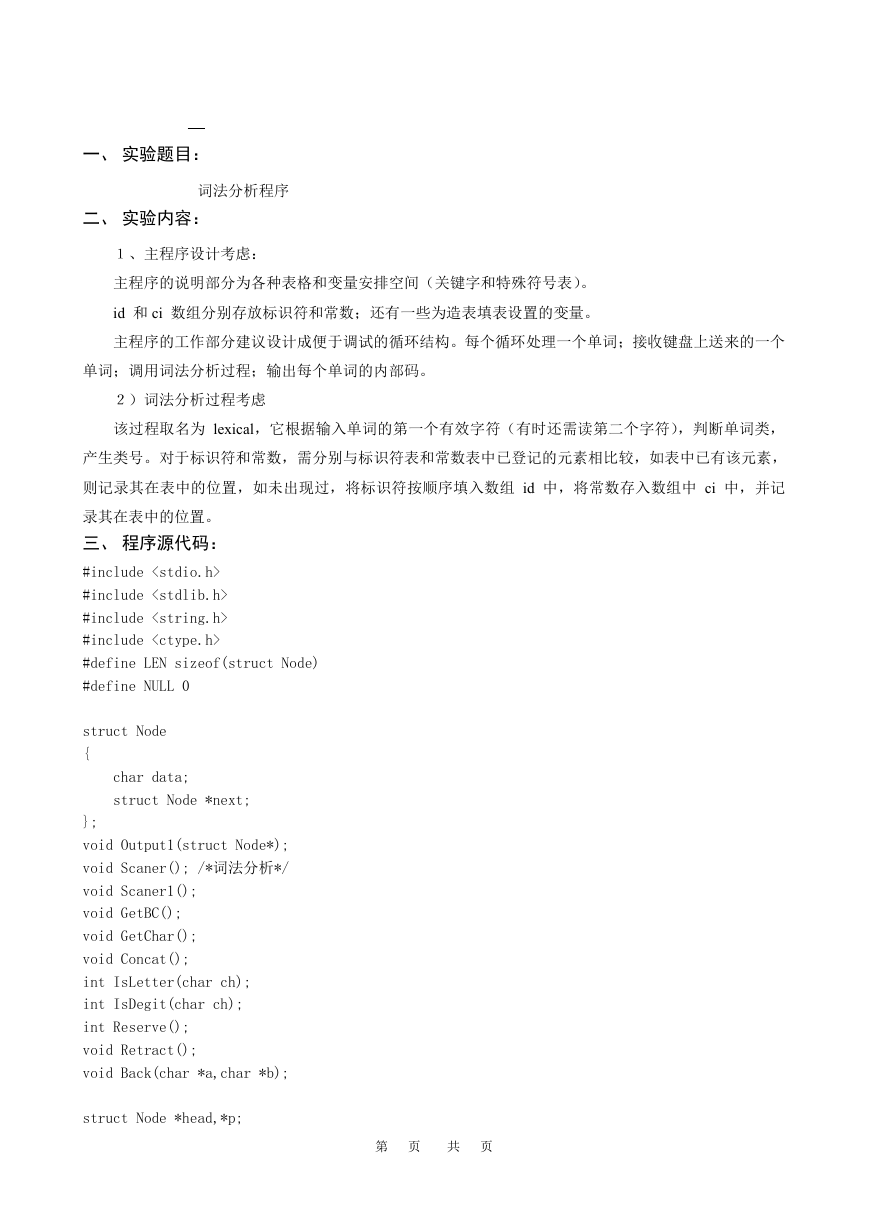
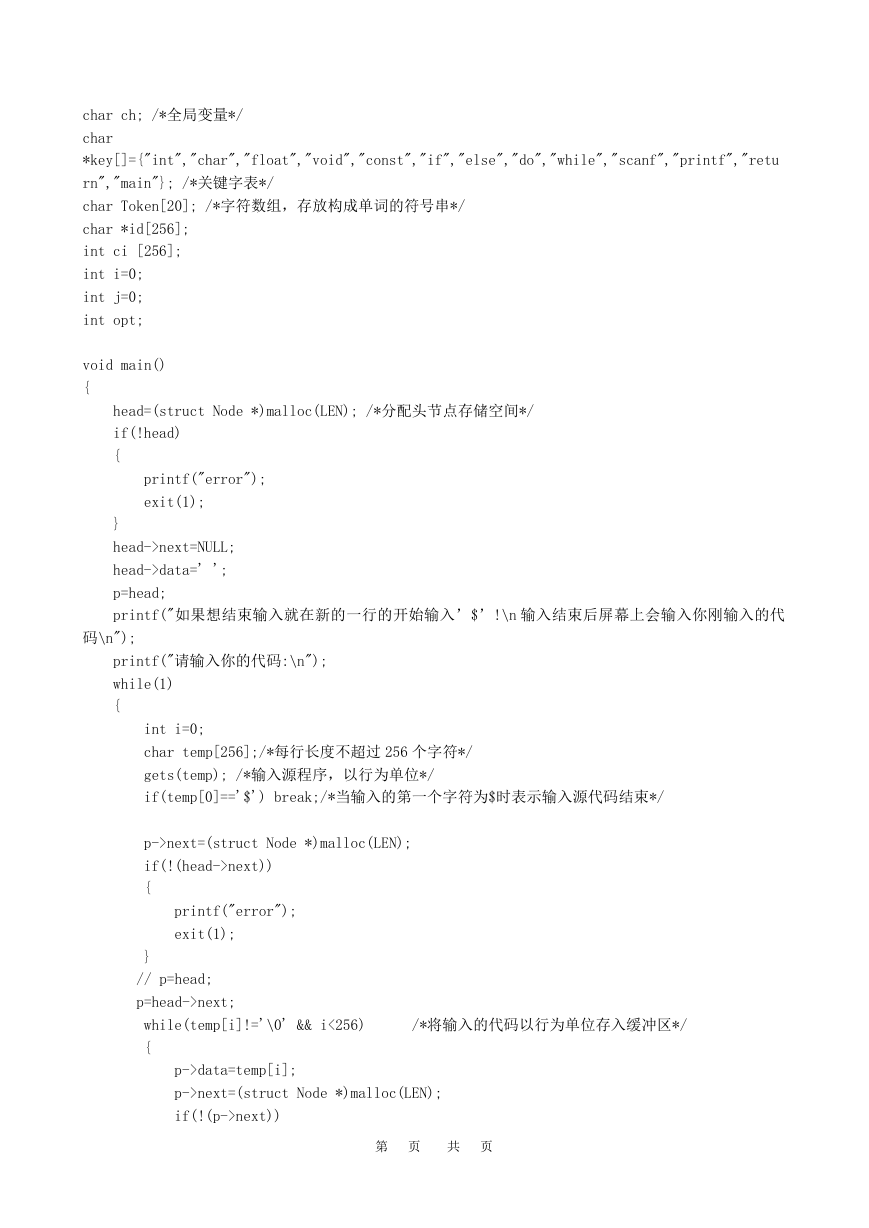
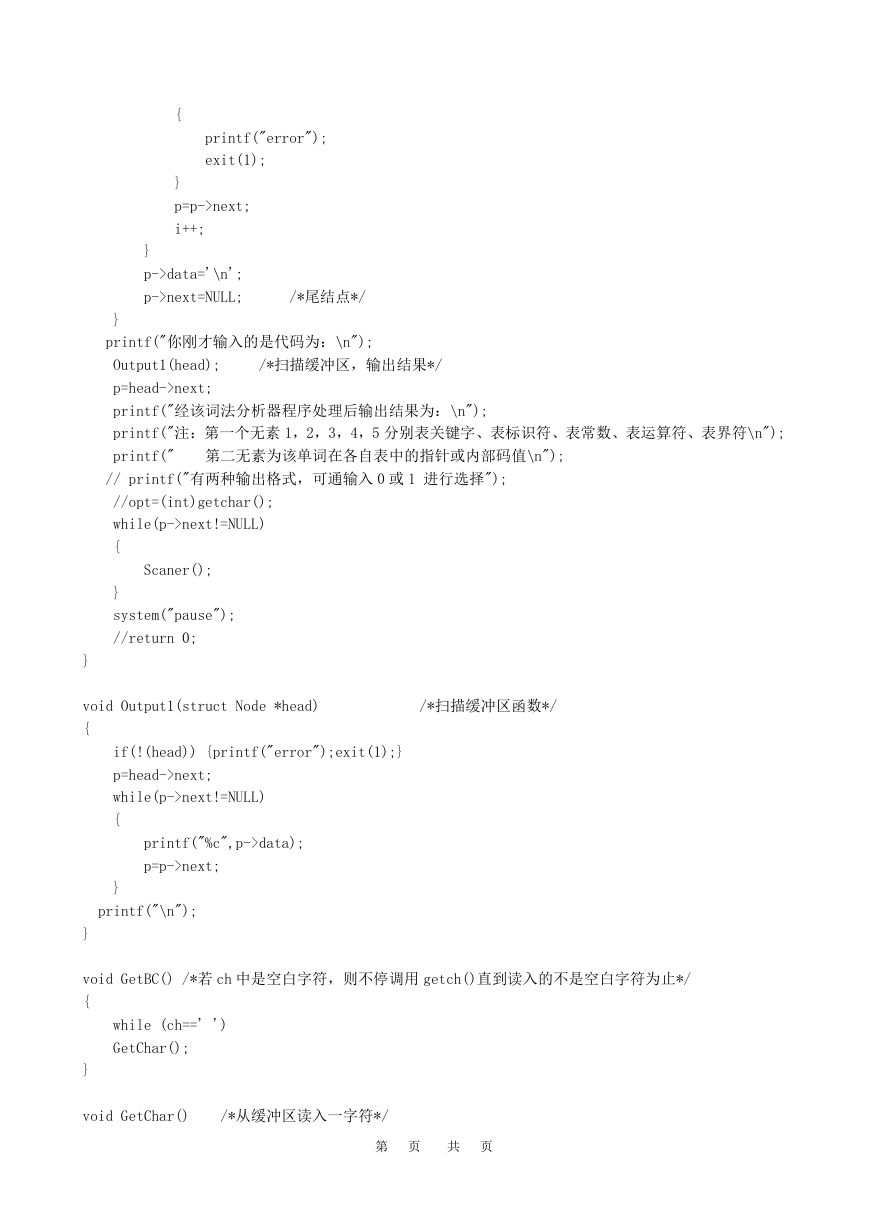
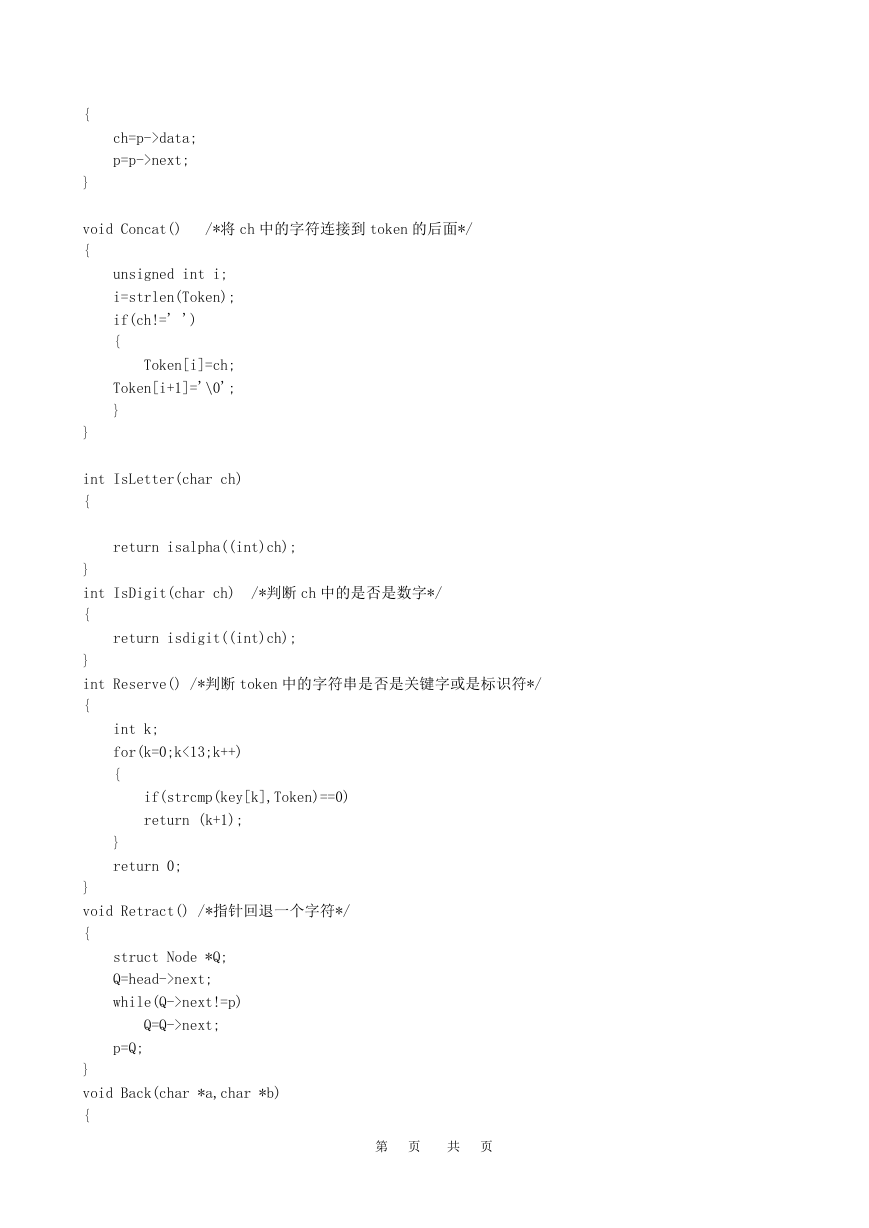
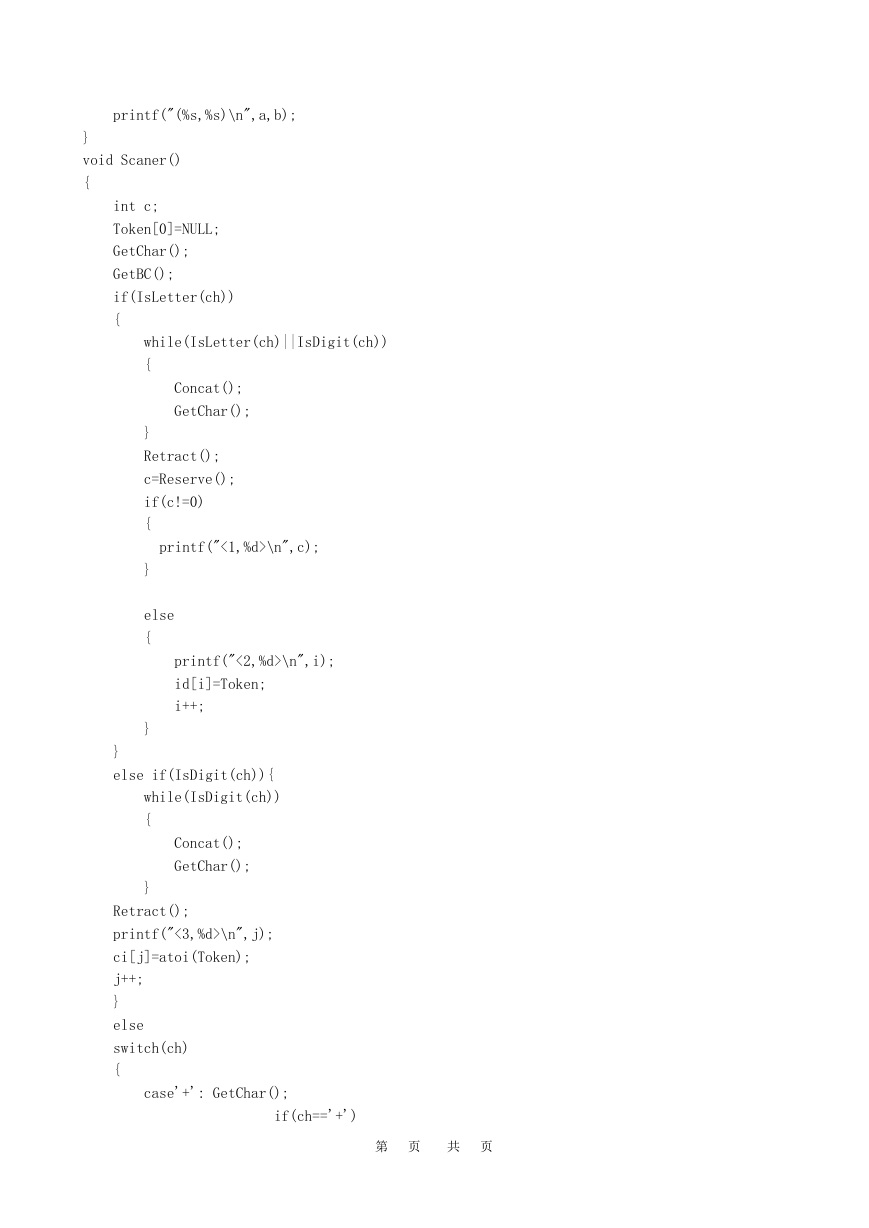
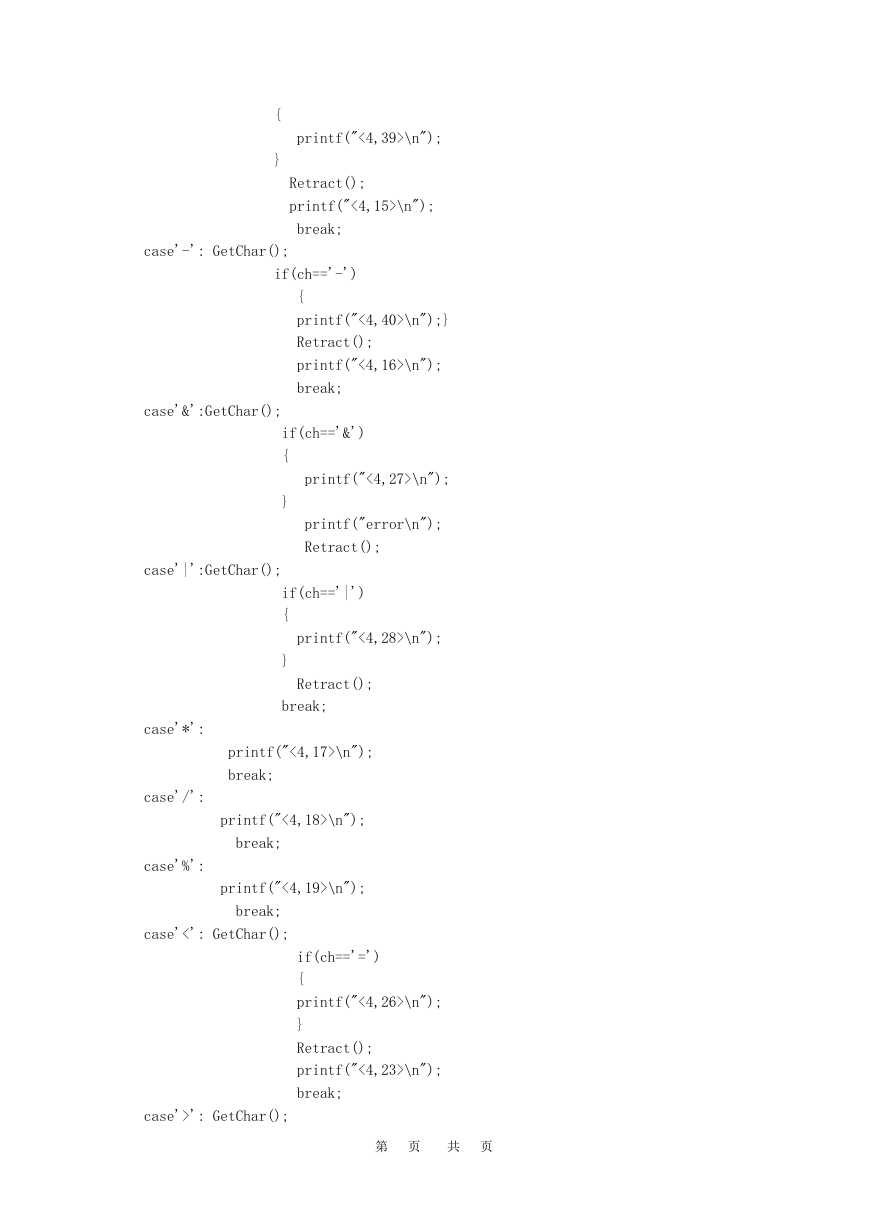
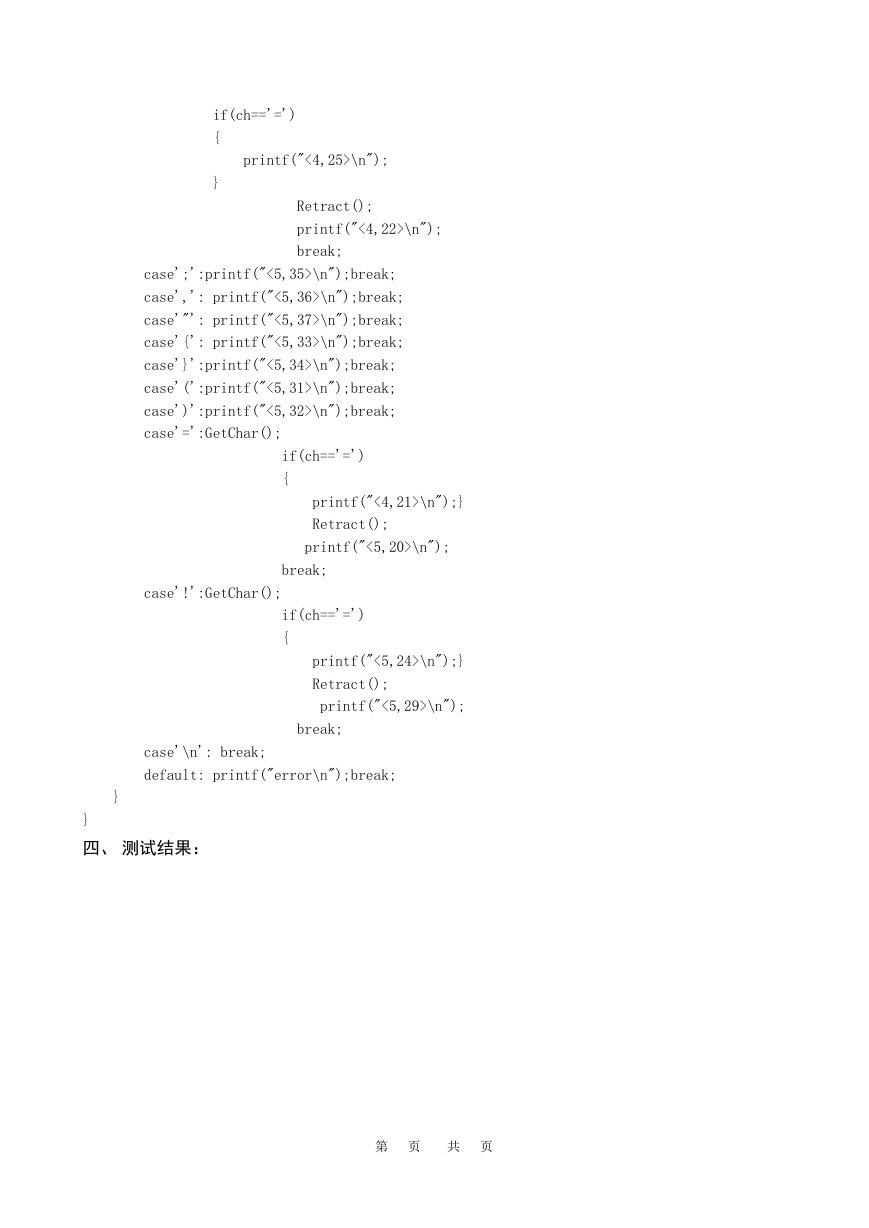
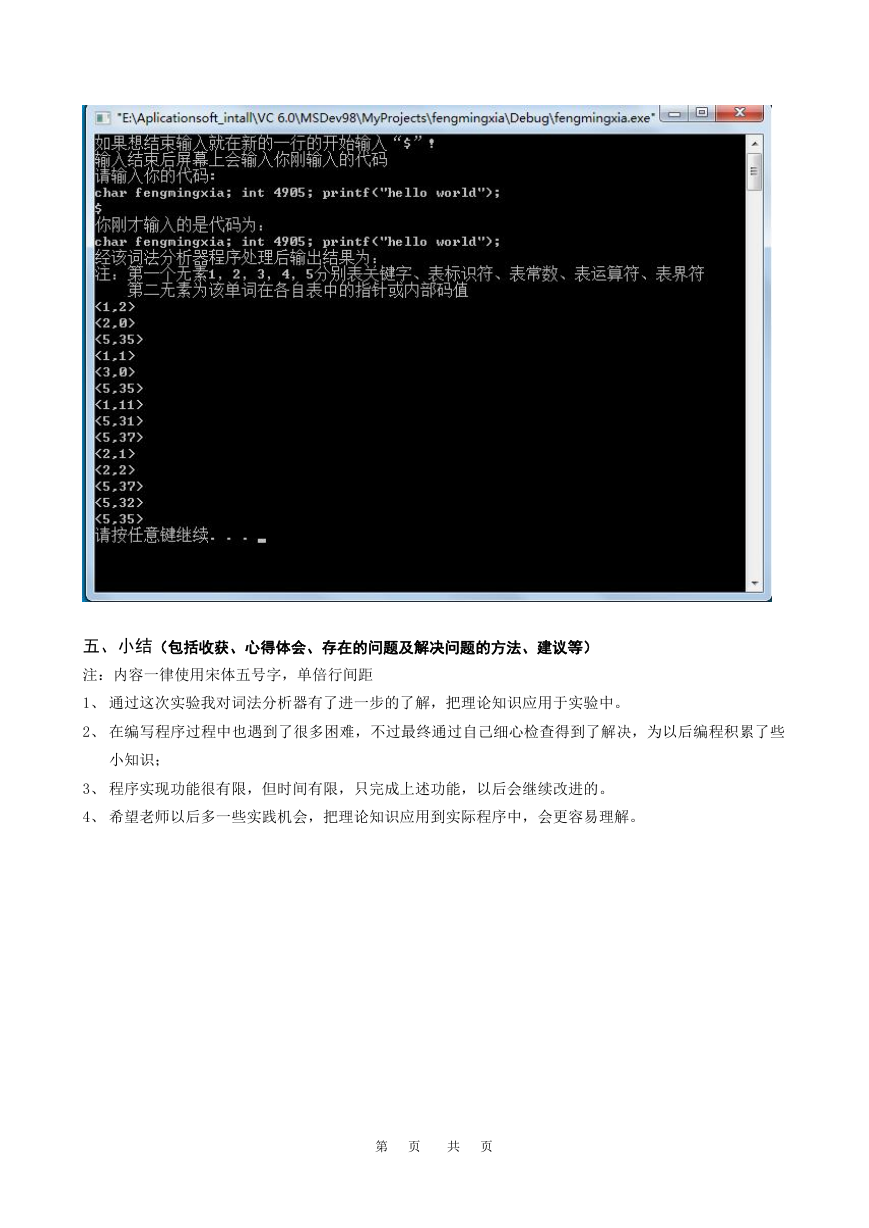








 2023年江西萍乡中考道德与法治真题及答案.doc
2023年江西萍乡中考道德与法治真题及答案.doc 2012年重庆南川中考生物真题及答案.doc
2012年重庆南川中考生物真题及答案.doc 2013年江西师范大学地理学综合及文艺理论基础考研真题.doc
2013年江西师范大学地理学综合及文艺理论基础考研真题.doc 2020年四川甘孜小升初语文真题及答案I卷.doc
2020年四川甘孜小升初语文真题及答案I卷.doc 2020年注册岩土工程师专业基础考试真题及答案.doc
2020年注册岩土工程师专业基础考试真题及答案.doc 2023-2024学年福建省厦门市九年级上学期数学月考试题及答案.doc
2023-2024学年福建省厦门市九年级上学期数学月考试题及答案.doc 2021-2022学年辽宁省沈阳市大东区九年级上学期语文期末试题及答案.doc
2021-2022学年辽宁省沈阳市大东区九年级上学期语文期末试题及答案.doc 2022-2023学年北京东城区初三第一学期物理期末试卷及答案.doc
2022-2023学年北京东城区初三第一学期物理期末试卷及答案.doc 2018上半年江西教师资格初中地理学科知识与教学能力真题及答案.doc
2018上半年江西教师资格初中地理学科知识与教学能力真题及答案.doc 2012年河北国家公务员申论考试真题及答案-省级.doc
2012年河北国家公务员申论考试真题及答案-省级.doc 2020-2021学年江苏省扬州市江都区邵樊片九年级上学期数学第一次质量检测试题及答案.doc
2020-2021学年江苏省扬州市江都区邵樊片九年级上学期数学第一次质量检测试题及答案.doc 2022下半年黑龙江教师资格证中学综合素质真题及答案.doc
2022下半年黑龙江教师资格证中学综合素质真题及答案.doc